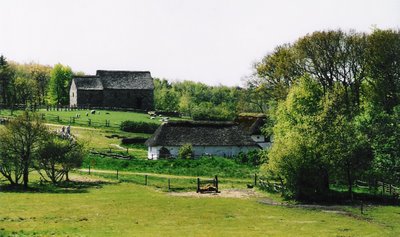Overview

Hjerl Hede, village
Wooden churches grew up in the cities and at the magnates' farms in those villages where Christianity advanced. There was no continuity between the pagan places and the Christian churches, although the church in Jelling was built in the middle of a pagan plan. The same goes for Hørning church north of Århus. The first wooden church was built with a grave hill as the center point - and a noble lady, who died shortly before the building, now rested in her hill directly below the choir.
The organization of the Danish church had began by Sweyn Tveskæg - under his rule English bishops came to Denmark - to the regrets from the archbishopric Hamburg-Bremen which until then had attempted to govern the development of the Danish church. Sweyns' successor Cnut the Great visited the papal court in Rome - another symbolic act from the dynasty which had placed itself not only at the Danish but also at the English throne.
In the middle of the 1000s the bishop in Ribe, Vale, had taken over the clerical supremacy of all Nørrejylland (district North Jutland), but after his death king Sweyn Estridsen divided Jutland north of Kongeåen (river) into four districts. Besides the two old bishoprics in Århus and Ribe a bishopric was established in the old thing-town Viborg and a bishopric for "the island Vendsyssel." Vendsyssel's cathedral was first built in Thy, in Vestervig, but in the early 1100s it was moved to Børglum in Vendsyssel. Furthermore existed the old bishopric in Schleswig which in the 1000s replaced Haithabu as the trading center of the district. Upon Funen was the bishopric in Odense established in the 900s, and the Roskilde church was from the same period. Skåne was divided into two bishoprics in Lund and Dalby, which later was transferred to Lund.

Hjerl Hede, model of church from the 1000s.
Christianity got hold of Denmark in Sweyn Estridsen's rule. The king's contemporary "history writer" Adam of Bremen says that in Sweyn's time were built 300 church in Skåne, 150 at Zealand, 100 at Funen: "The wildness has gone,the preachers of truth are gaining a footing everywhere. The altars of the idols have been broken down and churches are raised overall...." While the archbishopric in Hamborg-Bremen, supported by the pope, still tried to claim their rights of the clerical area in Denmark, it was the old Danish connection to England, which marked the Danish church in the late 1000s. Some bishops came from England and the first stone builders were inspired by the architecture on the other side of the North sea - and maybe the English building masters raised the first stone churches in the coast lands of Denmark. Most of the churches in Denmark were still wooden churches and they might not be situated in places where a stone church had to be built.
Source: Niels Peter Stilling, Danmarks Kirker, 2000
Next: The closters
photo: grethe bachmann
No comments:
Post a Comment